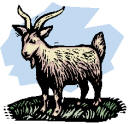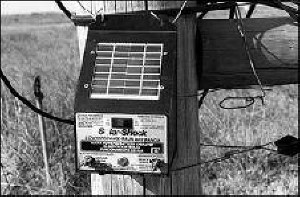

To send a message to an author, click on the author's name at the end of the article.
This Month in Ag Connection | Ag Connection - Other Issues Online

Goats are becoming more and more popular as a livestock animal. This is partially due to the increasing demand for goat products in this country. Whether you have goats for meat, milk, or just to clean up pastures, there are some basics to be aware of regarding breeding and kidding management.
Goats are seasonal breeders, meaning that they have a period of time during the year when they do not cycle and cannot be bred. The natural goat breeding season is from September through February. For this reason, goats are considered "short-day" breeders. During the breeding season, does will cycle and come into heat every 18-22 days.
This period of heat, technically named estrus, is when the female is receptive to the male for breeding. The heat will last 18 hours on average, and ovulation occurs 12-36 hours after the onset of heat. Signs indicating a doe is in heat are bleating, tail wagging, reddening and swelling of the vulva, discharge from the vulva, frequent urination and feed refusal.
A doe should reach 65-75% of her mature weight before being bred, and a properly fed doe should reach this weight at 8-9 months of age. Bucks reach puberty at 3-4 months of age but should not begin breeding until about 6 months. One buck can breed 2-3 times per week for the first 6 months of age and 20 times per week thereafter. It is important to maintain good herd health by administering yearly tetanus vaccinations, establishing a deworming program and maintaining hooves of all animals.
Gestation length of goats is approximately 5 months. This needs to be considered for deciding when to breed does. If a doe shows heat at the beginning of the breeding season in September, is bred and conceives, then she should kid in January. Kidding at that point of winter would not usually be ideal for this part of the country. It might be more feasible to breed does in November, resulting in a kidding time of March.
When kidding time is approaching, it is essential to be watchful. Keeping detailed records of heat and/or breeding dates can be very beneficial. Hand breeding can assist in more accurate record keeping, but for many producers it is more efficient to turn a buck into the pasture with the does. Common signs kidding time is approaching are the doe becomes withdrawn, bleats more frequently, eats less and has a white mucus discharge.
It is very common for does to have a smooth and uneventful delivery, but in the case of difficulty, it is important for you to be ready with help. Does have 2 kids on average. It is essential for kids to receive colostrum as soon as possible. Colostrum is the doe's first milk that provides immunity.
Dairy goat producers typically begin the weaning process at 2 weeks of age by introducing the kids to hay and grain, with the goal of completing weaning at 6-8 weeks of age. (either from mother or bottle). At weaning time it is advisable to tattoo for identification, clip wattles, disbud, de-scent, and castrate. Meat goat producers have more flexibility in the management of weaning and other practices.
Raising goats can be exciting and challenging. Proper reproductive management is an essential key to being successful.
(Author: Dee Cooper, Livestock Specialist)
This Month in Ag Connection | Ag Connection - Other Issues Online
In recent years there has been a proliferation of fence energizers (also called controllers or chargers) with increased capability, sophistication and cost. The better controllers can deliver a shock even under unfavorable conditions such as dry ground and with weeds or grass contacting the fence wire.
Fence chargers are typically powered by 6 or 12 volt batteries, by solar power or by 120 or 240 volt AC power. Heavy-duty batteries that are designed to withstand a deep discharge (deep cycle) before recharging are recommended. Use an AC charger if power is available. These models have more capability to deliver the voltage and intensity of shock required under unfavorable conditions in addition to saving the cost of batteries and the inconvenience of checking on and changing batteries.
Locate an AC charger where it will stay dry, be easily accessible for inspection and protected from livestock and small children. Do not use "homemade" chargers; they may, and often do, kill people and animals. Select a charger that is approved by Underwriters Laboratories (UL) or the U.S. Bureau of Standards.
Solar-powered chargers are battery units with a solar panel to keep the battery charged (Figure 1). The larger battery units may discharge a deep cycle battery in a week. It will take about 7 to 10 watts of solar panel per joule output, depending on the amount of sunlight and panel orientation. A 10-watt solar panel may cost $100 to $300.

Solar-powered fence energizers use a solar panel to charge a battery.
Desirable features of chargers include the following:
Be sure to properly ground whatever type of system you install.
Source: EQ379, Managed Grazing Systems and Fencing for Distribution of Beef Manure, http://extension.missouri.edu/publications/DisplayPub.aspx?P=EQ379
This Month in Ag Connection | Ag Connection - Other Issues Online
Missouri has a new tax credit designed to encourage cattle producers to put more weight on calves that are raised and backgrounded or finished in this state. The provisions for this credit can be found in Section 135.679 of the Missouri Revised Statutes. The short version - producers will receive a ten cent per pound tax credit if they keep feeder calves on the farm and add two hundred or more pounds to their frame before selling the calves.
The details as we know them - today!
Section 135.679 of the Missouri Revised Statutes can be found at: http://www.moga.state.mo.us/statutes/C100-199/1350000679.HTM
(Author: Parman Green, Agriculture Business Specialist)
This Month in Ag Connection | Ag Connection - Other Issues Online

With the cost of commercial fertilizer increasing, more farmers are starting to look for a less expensive source of nutrients. Poultry litter, for an increasing number of Missouri farmers, is becoming a natural choice as a low-cost fertilizer. When properly applied, poultry litter can be a valuable resource for grass, small grains and row crop production. The economics of using poultry litter varies considerably. To make economic decisions on the value of poultry litter, see UMC Guide G9330: Calculating Manure as a Fertilizer Source http://extension.missouri.edu/publications/DisplayPub.aspx?P=G9330
Poultry litter is made up of raw poultry manure and bedding materials such as sawdust, wood shavings or rice hulls. This combination provides an excellent source of organic nitrogen (N), phosphorus (P), potassium (K), and sulfur (S), as well as micronutrients and organic matter. The table below is the estimated range of nutrient concentrations in different types of poultry litter on a pound per wet ton basis. This information was provided by Dr. John Lory with University of Missouri Extension in the MU guide sheet G9340 Sampling Poultry Litter for Nutrient Testing: http://extension.missouri.edu/publications/DisplayPub.aspx?P=G9340
| Litter Type | Total N | Ammonia N | Phosphate | Potash |
|---|---|---|---|---|
| Broiler | 45 to 75 | 8 to 20 | 50 to 80 | 35 to 75 |
| Broiler Cake | 40 to 60 | 5 to 15 | 50 to 80 | 45 to 90 |
| Broiler Breeder | 20 to 50 | 5 to 15 | 40 to 70 | 15 to 55 |
| Turkey | 50 to 80 | 8 to 20 | 45 to 105 | 25 to 65 |
It is important to remember that poultry litter can be highly variable in the amount of nutrients it contains. Thus, to effectively use poultry litter as a fertilizer, a litter analysis should be done.
When applying poultry litter, it is important that farmers use proper litter management. Over-application or improper application timing of poultry litter can cause nutrient contamination (N and P) of surface and ground waters. Farmers should use this material in order to obtain maximum value of the fertilizer while preventing environment pollution.
Proper rate and timing of litter application is essential for efficient use of nutrients and the prevention of pollution. Litter should be applied as near to field crop planting dates and or forage crop growing season as possible. It is important to know that when you are determining litter rates only 60% of nitrogen in poultry litter is available as an N source in the year of application. Poultry litter has been shown to be a good fall N fertilizer for cool season pastures. Poultry litter should be applied until the soil test results show optimum phosphorus levels. At that point, the best option is to manage nutrient levels and apply nitrogen as required.
Poultry litter can be an excellent nutrient supply for farmers when a few good litter management steps are followed.
Good litter management steps are:
(Author: Joni Ross, Agronomy Specialist)
This Month in Ag Connection | Ag Connection - Other Issues Online
Water is a very important nutrient for livestock. Water quality can be a problem in the winter, especially after the dry weather we have been experiencing. Articles have been written in the past and this is a good time to go back and review them. Following is a link to an article printed in this newsletter in October 2004: http://agebb.missouri.edu/agconnection/newsletters/is-04-10.php#water
We often test forages for nitrates. Don't overlook your water supply as it could be high in nitrates. Care should be taken to exclude livestock from ponds, streams, etc. to avoid contamination of the water supply. If you suspect contamination of the water supply for your livestock, collect a sample of water using a clean plastic bottle. A soda or water bottle would be a good choice. When collecting from a water system, allow enough flow to replace all the water in the lines and dilute out the pressure tank. Then take the sample. Ponds may be sampled from the drain pipe. In unimproved ponds, sample so as to avoid mud contamination.
(Author: Don Day, Natural Resource Engineer)
This Month in Ag Connection | Ag Connection - Other Issues Online
Publishing Information
Ag Connection is published monthly for Northeast and Central areas of Missouri producers and is supported by the University of Missouri Extension, the Missouri Agricultural Experiment Station, and the MU College of Agriculture, Food and Natural Resources. Managing Editor: Mary Sobba.